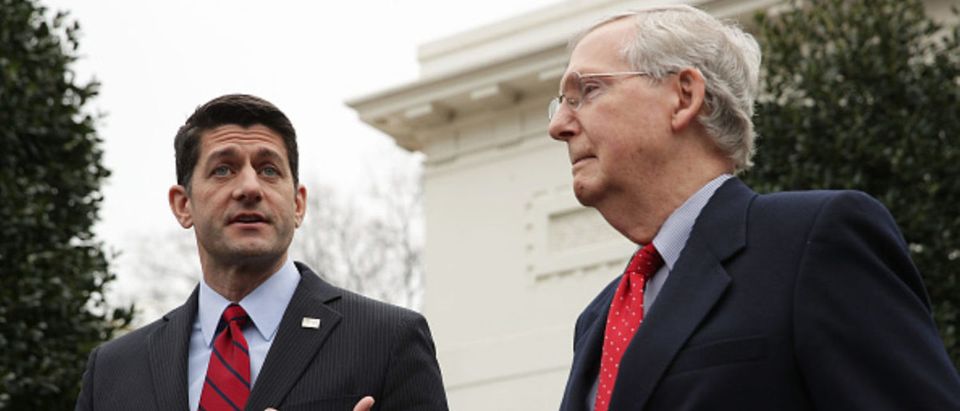The U.S. Senate Republicans failed to agree on a replacement for Obamacare, so Senate Majority Leader Mitch McConnell has announced that they will vote on the repeal-only bill that passed two years ago before being vetoed by President Obama. If they pass the repeal-only bill, they will have two years to come up with a replacement. Let us hope that they stick to healthcare and set political payoffs aside for another day.
For beginners, they should jettison the perverse provision that keeps 26 year-old children on Mommy and Daddy’s insurance policy. That was a political payoff to a group that voted overwhelmingly for President Obama in 2008. It increased the cost of Mommy and Daddy’s insurance and removed millions of healthy young people from the general pool leaving it older, sicker and costlier. Welcome to government healthcare!
When you begin reform with a political payoff you ought not be surprised to see your colleagues lining up with their political wish lists? Republican senators stepped up with their demands: more money!
The opioid crisis is real and urgent, but was not caused by our healthcare system and ought not be addressed in a reform of our healthcare system. It is being forced into the reform debate because there is a lot of money sloshing around. It should be addressed separately. Perhaps by the CDC.
The expansion of Medicaid to middle class America is wrong on two points. Medicaid costs were already out of control and Middle America will not tolerate the poor outcomes of the poverty program. A recent study concluded that Medicaid outcomes are no better than being uninsured.
There is a solution available. It is simple and already in place so it probably won’t be considered. And it is entirely market driven.
Prior to Obamacare the Federal Employees Health Benefit Plan was a cafeteria plan that allowed users to choose their coverage. It provided for routine fee for service plans, catastrophic plans, HMOs, PPOs and HSAs etc. The buyer drove the market and it was entirely provided by private insurers competing on service and price. The pool was large enough to cover pre-existing conditions.
Congress should pass a one-page bill allowing anyone and everyone to buy into the FEHBP. The three major goals are to allow policies to be sold across state lines, to allow individuals and small groups to form large buying pools and tort reform. The FEHBP solves the first two. Tort reform should be added.
In tort reform politicians have no business determining how large a judgment should be. We have juries for that. However, the loser in the lawsuit should pay all costs of the action. Doctors win the vast majority of malpractice claims that go to trial. Loser pays would reduce frivolous lawsuits allowing the market to rationalize defensive medicine. That alone could reduce healthcare spending by 25 percent.
Small businesses would buy into the FEHPB as well as individuals. Indeed, a big corporation may find it more convenient than running its own insurance company. Some states might choose it for their Medicaid population.
It would be a huge pool that would spread risk naturally, not by mandate, and could cover all pre-existing conditions. The coverage would be portable when changing jobs solving another major health insurance issue. No bureaucratic rules or oversight are necessary.
The management of the FEHBP should be removed from government and given to a private board comprised of insurance experts as well as other disciplines.
There are about 11 million people on Obamacare. About half of those lost insurance they were content with because of Obamacare. They would love this choice and millions of uninsured will buy in if they can choose what they are willing to pay for.
All coverage options, as well as doctor, hospital and pharmacy prices, should be posted on the Internet so that people could shop. Private businesses would spring up to help people navigate the choices.
For those who cannot afford FEHBP premiums, we have 9,000 community health centers. That number should be increased with the expansion going to rural and poor areas and no one will be without primary health care. The costs could be shared on a federal-state formula.
Last year Obamacare cost $110 billion so there is a lot of room to make this work and still save money. Rather than a costly bureaucratic regime to subsidize premiums, we can help fund state high-risk pools to pay for catastrophic injury or disease for those using the CHCs.
I think the president would embrace this idea. He can tell America: “You can buy the same coverage that Congress has and if you cannot afford the premium you can get care for free at the community health center.”
The media and Democrats will argue that the American people are not up to making these decisions. That’s a fight worth having.
If you would like to be added to John Linder’s distribution list please send your email address to:linderje@yahoo.com or follow on Twitter: @linderje


